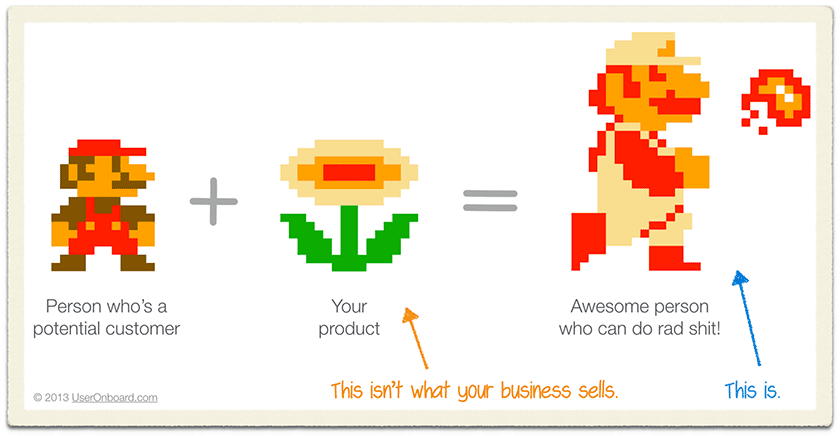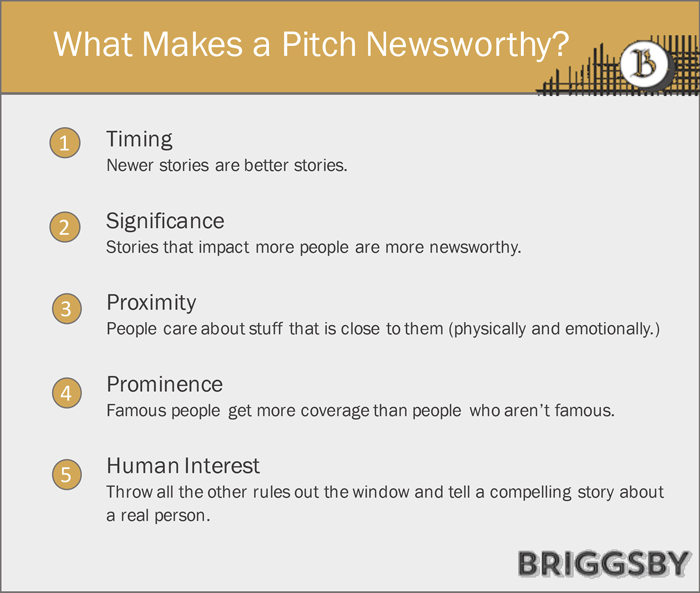Everyone says that good PR and good content marketing are all about relationships. That’s great, but what happens when you don’t have any?
You’re not out of luck. Major features from top-tier publishers, articles on niche blogs, and endorsements from social influencers are all within reach — even if you’re a nobody — as long as you can write a good pitch.
Define Your Value Proposition
One of the best places to start is by defining your value proposition.
In product marketing and conversion copywriting, value propositions explain, in just 1-2 sentences, the benefits of using your product over the competition. Value props are more than a list of the product’s features, they’re about how people’s lives will be better once they start using your product.

Defining a Value Prop (via User Onboarding)
In digital PR and content marketing, value propositions functions similarly. Instead of selling a product, they’re selling a post idea.
Find the Newsworthy Angle
That post idea has to be a good one, and, usually, good ideas aren’t just “Hey, write about this product, please.” Instead, good ideas latch on to already successful topics and present new and interesting angles.
Finding a “new and interesting” angle boils down to these five elements of newsworthiness:
- Timing: the newer the better
- Significance: how many people are affected (usually, more=better)
- Proximity: people care about stuff that’s close to them (physically and/or emotionally)
- Prominence: famous people get more coverage than people who are not famous
- Human Interest: throw all the other rules out the window and tell a good story about a real person

Elements of a Newsworthy Pitch
There are a lot of ways to make your story newsworthy: find a local angle on a national story, show how a broad trend is impacting a very specific group of people, tell a good story about moms just before Mother’s Day. Tie your pitch to broader social conversations and interests.
Find the Newsworthy Benefits
The features you highlight in your pitch may not be the same features that the sales department prioritizes. This is fine. It’s your job to go with the story that will earn you coverage.
Cater your features and benefits messaging to the publishers you’re pitching. You may end up with one pitch value proposition that’s all about your green, eco-friendly production process and another one that’s about your startup’s unique approach to product development. It’s better to have more, very specific pitch messages than a few broad, catch-all pitches.
Stick to the Facts
You’ll be pitching bloggers and journalists who value facts over fluffy PR-speak, so your value prop needs to convey why your product/content is awesome without ever using words like new, awesome, exciting, or great. The greatness needs to be evident in the facts you share.
Here are some good examples of value propositions and pitches that clearly express their product’s benefits using features and facts:
“SuperBetter is a mobile game built by author and TED speaker Jane McGonigal designed to get you on the road towards being a more resilient individual. A paper published in the March edition of Clinical Psychological Science, shows the game can decrease anxiety in some users after just 25 minutes of use.”
“With Hulu, you can watch all-new episodes and full seasons of the best TV shows on all your devices with limited advertising.”
“The MacBook Air features new fifth-generation Intel Core processors, Thunderbolt 2, and, as always, all-day battery life.”
Build Trust
The people you’re pitching don’t know who you are and have no reason to trust you. Even though you’re aiming for a short message, include one or two tidbits that show you’re a trustworthy source. If you surveyed 1,000 people for your study, mention that. If you’re pitching a startup and the company’s founder has experience at a majorly successful organization, mention that.
Actually Write the Value Prop
With a good understanding of what makes your story newsworthy, and which benefits are most important to that story, write out the value proposition for your pitch. Keep it to three sentences or fewer. (Bloggers and journalists value brevity when it comes to pitches.)
Your value prop will be the core of your pitch. Beyond that, you really just need a link to a landing page with more product details and visual assets.
Craft Your Email & Minimize Friction
Once you’ve nailed down your value proposition, your next goal is to minimize the friction required to write about your product/content. Ideally, writers shouldn’t have to respond to your email at all. (It sounds crazy, I know.) Your pitch should give them everything they need to write and publish a post: a compelling story angle, a detailed landing page to learn more, and images/videos.
Find the Right Length
Your email should be as short as possible, while still providing the writer everything he or she needs to put together a story. One way to achieve this is by keeping your messaging concise and linking to a landing page that has more details, including video and image assets.
Use Professional-Quality Images and/or Video
Most writers are required to use images in their posts. Make their job as easy as possible by providing super high-quality photos, graphics, and videos for them to use. (Don’t attach them to the email. Link to a landing page that has them.)
This is where “good content” can be the difference between major coverage and crickets. If you’re pitching content, make sure you have well-designed charts, graphs, and images to accompany your piece. If you’re pitching products, invest in professional product photos that feature real people.
Personalize Every Pitch
Though you’re working from a template, every email you send should be personalized. At bare minimum, this means finding the exact right person to pitch and using their first name in the greeting. Ideally, it also means strategically calling out the very specific benefits the writer will care about.
You can add personal notes, like if you really connected with another article they wrote or if you find out you’re from the same hometown. I usually save this type of note for the end of my email (often as a P.S.), so it doesn’t distract from the business of the pitch.
Get out of the way
Don’t bother talking about who you are (especially if you’re working agency-side). That sentence about “Hi, I’m so-and-so and I’m writing about brand because….” — cut it, and get right to the value prop instead. Unless you’re famous, you don’t need to talk about yourself at all.
Pitch the Big Sites First
Big sites often want to the ones to break a story and won’t cover items that have already been covered by a bunch of smaller sites. Smaller sites are usually less picky.
A/B Test Your Pitch
Try changing your subject line, the flow of your pitch, or the benefits you call out in your value prop. You’ll often find that one email variation seriously outperforms the rest.
Turn the Coverage You Get into Relationships
While you definitely don’t need relationships to get coverage, they do make it easier, especially when you have less exciting news to share. Use this campaign as a catalyst to build relationships for future pitches.
Send thank you emails to the bloggers and journalists who write about you. Mention that you’re available if they need commentary/data/products (whatever you can offer) for future pieces. Keep track of them and give them early access the next time you have something to pitch.
What are your thoughts on pitching without relationships? Let us know on Twitter or send us an email.

